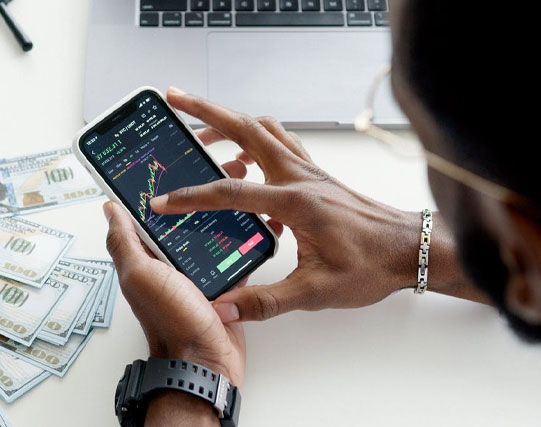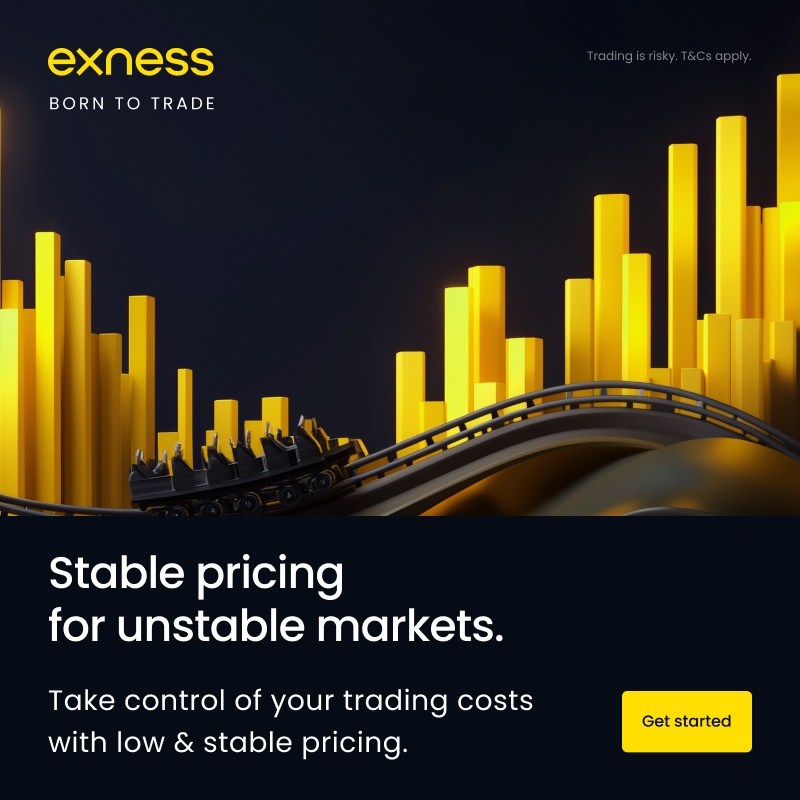
9 minute read
How to Start Forex Trading in Namibia: A Comprehensive Guide
from Exness
by Exness_Blog
Forex trading, or foreign exchange trading, is gaining momentum in Namibia as an accessible way to participate in the global financial markets. With a daily trading volume exceeding $7.5 trillion, the forex market offers opportunities for Namibian traders to diversify their portfolios and potentially generate profits. However, starting forex trading in Namibia requires careful planning, education, and adherence to local regulations.
Top 4 Best Forex Brokers in Namibia
1️⃣ Exness: Open An Account or Visit Brokers 🏆
2️⃣ XM: Open An Account or Visit Brokers 💥
3️⃣ JustMarkets: Open An Account or Visit Brokers ✅
4️⃣ Quotex: Open An Account or Visit Brokers 🌐
What is Forex Trading?
Forex trading involves buying and selling currency pairs to profit from fluctuations in exchange rates. For example, in the EUR/USD pair, you speculate on whether the euro will strengthen or weaken against the U.S. dollar. The forex market operates 24 hours a day, five days a week, and is decentralized, meaning trades occur over-the-counter (OTC) through banks, brokers, and financial institutions.
In Namibia, forex trading is legal, regulated by the Namibia Financial Institutions Supervisory Authority (NAMFISA) and the Bank of Namibia (BoN) under the Financial Institutions and Markets Act, 2021, and the Currency and Exchanges Act, 1933. These regulations ensure transparency and protect traders, but Namibians must trade through licensed brokers or authorized dealers, such as commercial banks or bureaus de change.
Why Trade Forex in Namibia?
Namibia’s growing internet penetration (51%, or roughly 1.37 million users) and stable economic environment make it a fertile ground for forex trading. The Namibian dollar (NAD) is pegged 1:1 to the South African rand (ZAR), which is highly volatile and widely traded, offering opportunities for short-term speculation. Additionally, forex trading in Namibia offers:
· Accessibility: Start with a small investment, as low as $50 with some brokers.
· Flexibility: Trade 24/5, fitting around your schedule.
· High Liquidity: Easily convert assets to cash without delays.
· Leverage: Amplify potential profits (but also risks) with borrowed funds.
However, the NAD’s lower liquidity limits its availability on most platforms, so Namibian traders often focus on ZAR-based pairs like USD/ZAR or EUR/ZAR.
Step-by-Step Guide to Start Forex Trading in Namibia
1. Educate Yourself on Forex Basics
Before risking real money, understand the forex market’s fundamentals. Key concepts include:
· Currency Pairs: Traded in pairs (e.g., USD/NAD, EUR/USD). The first currency is the base currency, and the second is the quote currency.
· Pips: The smallest price movement in a currency pair, typically the fourth decimal place (e.g., 0.0001).
· Leverage: Borrowing funds to increase trade size (e.g., 1:100 leverage means $1 controls $100). Use cautiously, as it magnifies losses.
· Spread: The difference between the bid (sell) and ask (buy) price, representing the broker’s commission.
· Lot Size: A standard lot is 100,000 units of the base currency. Micro-lots (1,000 units) are ideal for beginners.
Resources like webinars, online courses, and broker-provided tutorials can help. Platforms like AvaTrade offer the SharpTrader Academy, while Tickmill provides extensive educational materials. Practice with a demo account to simulate real trading without financial risk.
2. Understand Namibia’s Forex Regulations
Forex trading is legal in Namibia, but strict rules apply:
· Authorized Dealers: Trades must go through commercial banks, registered brokers, or bureaus de change, as mandated by the BoN.
· Licensing: Brokers must hold a valid NAMFISA license or be regulated by reputable international authorities like the Financial Sector Conduct Authority (FSCA) in South Africa, ASIC in Australia, or FCA in the UK.
· Capital Limits: Namibians can invest up to N$1 million via the Single Discretionary Allowance and N$4 million via the Foreign Investment Allowance annually.
· Taxation: Forex profits are subject to personal income tax under Namibia’s progressive rates. Keep detailed records and consult a tax professional to comply with the Namibia Revenue Agency (NamRA).
Avoid unregulated brokers, as they pose risks of fraud and fall outside Namibian jurisdiction. Check NAMFISA’s public register to verify a broker’s license.
3. Choose a Reputable Forex Broker
Selecting a broker is critical. Consider these factors:
· Regulation: Prioritize brokers regulated by NAMFISA or top-tier authorities (FSCA, ASIC, FCA, CySEC). Examples include Exness, AvaTrade, XM, and Tickmill.
· Trading Platforms: Look for user-friendly platforms like MetaTrader 4 (MT4), MetaTrader 5 (MT5), or proprietary platforms like AvaTradeGO.
· Fees: Compare spreads (e.g., 0.8 pips on EUR/USD with XM) and commissions (e.g., $6 per lot with FP Markets). Avoid brokers with hidden fees.
· Account Types: Opt for micro or cent accounts for low-risk trading. Exness offers flexible accounts with no minimum deposit.
· Payment Methods: Ensure the broker supports local options like bank transfers or mobile payments (e.g., DPO in Namibia).
· Customer Support: Choose brokers with 24/5 multilingual support, like XTB or AvaTrade.
Top brokers for Namibian traders include:
· Exness: FSCA-regulated, with high leverage (1:2000) and local payment support. Ideal for beginners and scalpers.
· AvaTrade: Regulated by FSCA and ASIC, with a $100 minimum deposit and commission-free trading. Offers social trading via AvaSocial.
· Tickmill: Regulated by FCA and CySEC, with a $100 minimum deposit and raw spreads from 0.0 pips.
· XM: FSCA-regulated, with a low minimum deposit and 55+ currency pairs.
· FP Markets: Offers MAM/PAMM accounts for passive trading, with raw spreads from 0.0 pips.

💥 Trade with Exness now: Open An Account or Visit Brokers 🏆
4. Set Up a Trading Account
Once you’ve chosen a broker, follow these steps:
· Register: Provide personal details, including proof of identity (passport, ID card) and proof of residence (utility bill). Complete the Know Your Customer (KYC) process.
· Choose an Account Type: Start with a demo account to practice, then transition to a live micro or standard account.
· Download the Platform: Install MT4, MT5, or the broker’s proprietary platform on your desktop or mobile device.
· Fund Your Account: Deposit funds via bank transfer, card, or local payment methods. The BoN recommends a minimum of N$1.6 million for international accounts, but many brokers accept $50–$100.
Ensure your internet connection is stable, as forex trading requires real-time data. Run a speed test before trading.
5. Develop a Trading Strategy
A solid strategy minimizes risks and maximizes profits. Common approaches include:
· Technical Analysis: Use charts, indicators (e.g., Moving Averages, RSI), and candlestick patterns (e.g., Bullish Engulfing) to predict price movements.
· Fundamental Analysis: Analyze economic indicators (GDP, inflation, employment) and geopolitical events (elections, trade agreements) to understand currency strength.
· Hybrid Approach: Combine technical and fundamental analysis for balanced decisions.
Key risk management tools:
· Stop-Loss Orders: Automatically exit a trade at a set loss level to limit losses.
· Take-Profit Orders: Lock in profits at a target price.
· Trailing Stops: Adjust stop-loss levels as the market moves in your favor.
· Risk-Reward Ratio: Aim for a ratio of at least 1:2 (e.g., risk $100 to gain $200).
Start with a trading plan outlining your risk tolerance, profit goals, and evaluation criteria. Avoid emotional trading by sticking to your plan.
6. Place Your First Trade
After practicing on a demo account, place your first live trade:
· Select a Currency Pair: Focus on major pairs (e.g., EUR/USD, USD/ZAR) due to their liquidity and tight spreads.
· Analyze the Market: Use technical or fundamental analysis to predict price direction.
· Set Order Type: Choose a market order for instant execution or a limit order for a specific price.
· Apply Risk Management: Set stop-loss and take-profit levels.
· Execute the Trade: Monitor the position and adjust as needed.
For example, if you fund your account with N$2 million and convert to USD at N$1 = $0.057, you’d have $114,000. If the NAD weakens to $0.054, converting back yields N$2,111,111, a profit of N$111,111.
7. Stay Disciplined and Keep Learning
Forex trading requires continuous improvement:
· Track Performance: Maintain a trading journal to analyze wins and losses.
· Stay Updated: Follow economic news via platforms like Bloomberg or Reuters.
· Avoid Scams: Beware of brokers promising guaranteed returns or unregulated platforms.
· Join Communities: Engage with Namibian forex traders on forums or social platforms like eToro for insights.
Best Times to Trade Forex in Namibia
Namibia operates in the Central Africa Time (CAT) zone (UTC+2). The best trading times align with major market overlaps:
· London Session (10:00–19:00 CAT): High liquidity for EUR, GBP, and CHF pairs.
· New York Session (15:00–23:00 CAT): Active for USD pairs, especially during the London overlap (15:00–19:00 CAT).
Avoid trading during low-liquidity periods (e.g., Asian session, 01:00–09:00 CAT) to minimize slippage.
Common Mistakes to Avoid
· Overleveraging: High leverage can wipe out your account. Use 1:10 or lower as a beginner.
· Ignoring Risk Management: Always set stop-loss orders and risk no more than 1–2% per trade.
· Chasing Losses: Stick to your plan instead of making impulsive trades.
· Neglecting Taxes: Report all profits to NamRA to avoid penalties.
· Trading Without a Plan: Emotional decisions lead to losses.
Recommended Brokers for Namibian Traders
Based on regulation, fees, and features, these brokers stand out:
· Exness: Ideal for low-cost trading with high leverage.
· AvaTrade: Best for beginners, with educational resources and social trading.
· Tickmill: Competitive spreads for scalpers and algorithmic traders.
· XM: Low minimum deposit and diverse currency pairs.
· FP Markets: Suited for passive traders with MAM/PAMM accounts.
Always verify a broker’s license via NAMFISA or international regulators.
Conclusion
Starting forex trading in Namibia is an exciting opportunity to engage with global markets, but success requires education, discipline, and compliance with regulations. By understanding the basics, choosing a regulated broker, developing a strategy, and managing risks, beginners can build a strong foundation. Use demo accounts to practice, stay informed, and avoid common pitfalls like overleveraging or trading with unregulated brokers.
With Namibia’s growing internet access and stable economy, forex trading offers a pathway to financial growth. Start small, stay disciplined, and leverage resources from trusted brokers like Exness, AvaTrade, or Tickmill to embark on your trading journey confidently.
💥 Note: To enjoy the benefits of the partner code, such as trading fee rebates, you need to register with Exness through this link: Open An Account or Visit Brokers 🏆
Read more:


